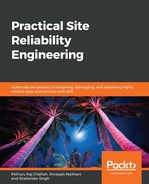Today, software-defined cloud centers are very popular and profoundly leveraged for business agility, affordability, and productivity. The cloud idea fulfils the infrastructure's automation, optimization, and utilization requirements. The faster maturity and stability of the virtualization movement makes the hardware programming a grand reality. Therefore, infrastructure as code is the buzzword in the IT industry these days. IT infrastructure monitoring, measurement, and management are seeing a lot of delectable advancements with the rise of the cloud paradigm. A variety of IT infrastructure operations are being automated and accelerated through a host of advanced and standardized tools. The simultaneous rise of the DevOps concept, along with a flurry of powerful cloud technologies and tools, has brought in scores of strategic automation and optimization in the IT space. IT self-service, pay-per-usage, and elasticity have become the core IT capabilities.
Cloud service providers invest their talents, time, and treasures in grandiosely automating several tasks of cloud centers, such as load balancing, workload consolidation, continuous integration, deployment and delivery, task and resource scheduling, workflow automation through integration and orchestration, information security, auto-scaling, replication, and VM placement. There is little to no involvement, interpretation, and instruction from humans in successfully running cloud centers that are increasingly hosting a growing array of web, mobile, enterprise, embedded, transactional, operational, and analytical applications. The cloud journey is definitely on the right track, gaining more mind and market shares as days pass by.
In the recent past, containerization is fast penetrating and immensely participating in cloud-inspired IT automation. Some of the persistent drawbacks of virtualization are being surmounted through containerization. The rise of containers, container orchestration, and management tools, such as Kubernetes, microservices-centric cloud applications (native, as well as enabled), and multi-container applications, is leading to the emergence of containerized clouds. Container images are being projected and positioned as the best in class format for application packaging, distributing, shipping, and running any software applications in a highly portable fashion. The convergence of containers and microservices is laying a stimulating and sparkling foundation for next-generation IT environments.
The continued addition of pioneering automation in the IT space is leading to sophisticated and smart infrastructure. The rise of containers, container orchestration, microservices, cloud-native architectures, container-defined-storage, and container-defined-networking lead us to the next phase of infrastructure. Today, we have data centers and server farms blessed by cloud technologies. Also, we have containerized and virtualized cloud environments for meeting different use and business cases. We have public, private, and hybrid clouds leveraging the proven virtualization and potential containerization paradigms.
The cloud journey, starting with bare metal servers, virtual machines, and containers is now tending toward functions. That is, functions emerge as the new deployment and delivery unit. The flourishing model of serverless computing is to automate the various backend services to run functions comfortably. That is, the days of Function as a Service (FaaS), a new business model, is to see reality. That is, developers just focus on creating functions and upload their functions to the cloud. The function deployment, resource provisioning, and infrastructure elasticity for function scalability are being automatically performed by cloud service providers. Thus, the modern infrastructure is to handle the intricacies of serverless computing.
The power of the Internet of Things (IoT) technologies and tools establishes a deeper and extreme connectivity among the various physical, mechanical, electrical, and electronic devices. Thus, the world is to comprise trillions of digitized entities, billions of connected devices, and millions of software services in the years to unfold. With connected and embedded devices joining in the mainstream computing, there are needs being expressed widely for formulating and firming up edge or fog cloud environments to fulfil real-time data capture, storage, processing and analytics, decision-enablement, and actuation requirements. Thus, the modern infrastructure has to fulfil the nuances of edge or fog computing.
Another paradigm shift is being associated with the faster spread of graphical process units (GPUs), which act as a complement to the pervasive CPUs. A number of cores can be accommodated in GPUs, and hence GPUs are more popular with cluster and parallel computing models. Big data analytics and data science experiments can be accomplished through the leverage of GPU clusters. As containers do well as the optimized runtime environment for applications and microservices, the future beckons for containerization-inspired data analytics. We have written about the role of Kubernetes in creating and running multi-container applications in detail.
Apart from containerized clouds, hyper-converged infrastructure (HCI) solutions are also emerging for different business cases. An HCI typically comes with a software-enabled horizontal scaling capability while tightly integrating compute, storage, and networking resources in a commodity hardware box. A converged infrastructure (CI) or appliance is another highly expensive but robust and turn-key infrastructure solution for application hosting and delivery. Thus, there are lean, dynamic, and adaptive IT infrastructure modules emerging and evolving fast for optimally running business workloads and cloud applications. The challenge is to make the modern infrastructure reliable to fulfil the long standing goals of reliable businesses. There are various ways being recommended. This chapter is going to convey how diagnostic and prognostic analytics on infrastructure log and operational data gives the insights to work upon the reliability goals.
